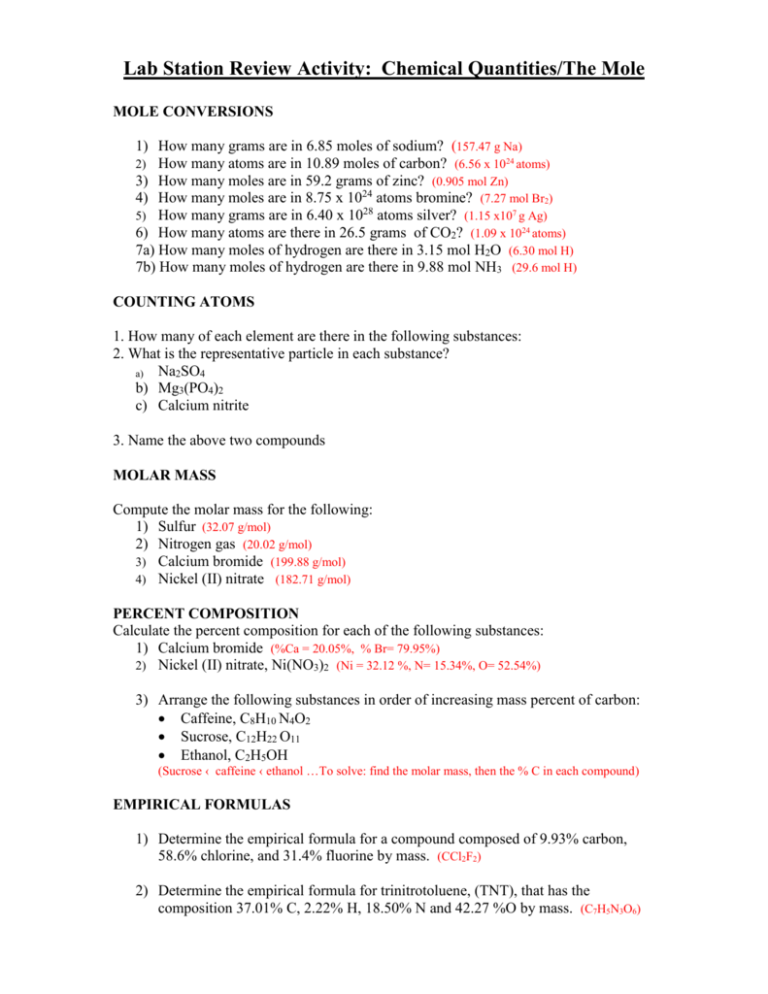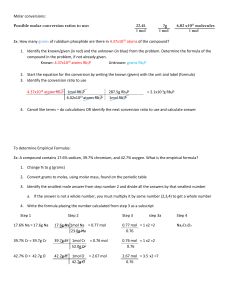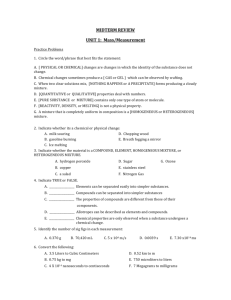Lab Station Review Activity: Chemical Quantities/The Mole
advertisement

Lab Station Review Activity: Chemical Quantities/The Mole MOLE CONVERSIONS 1) How many grams are in 6.85 moles of sodium? (157.47 g Na) 2) How many atoms are in 10.89 moles of carbon? (6.56 x 1024 atoms) 3) How many moles are in 59.2 grams of zinc? (0.905 mol Zn) 4) How many moles are in 8.75 x 1024 atoms bromine? (7.27 mol Br2) 5) How many grams are in 6.40 x 1028 atoms silver? (1.15 x107 g Ag) 6) How many atoms are there in 26.5 grams of CO2? (1.09 x 1024 atoms) 7a) How many moles of hydrogen are there in 3.15 mol H2O (6.30 mol H) 7b) How many moles of hydrogen are there in 9.88 mol NH3 (29.6 mol H) COUNTING ATOMS 1. How many of each element are there in the following substances: 2. What is the representative particle in each substance? a) Na2SO4 b) Mg3(PO4)2 c) Calcium nitrite 3. Name the above two compounds MOLAR MASS Compute the molar mass for the following: 1) Sulfur (32.07 g/mol) 2) Nitrogen gas (20.02 g/mol) 3) Calcium bromide (199.88 g/mol) 4) Nickel (II) nitrate (182.71 g/mol) PERCENT COMPOSITION Calculate the percent composition for each of the following substances: 1) Calcium bromide (%Ca = 20.05%, % Br= 79.95%) 2) Nickel (II) nitrate, Ni(NO3)2 (Ni = 32.12 %, N= 15.34%, O= 52.54%) 3) Arrange the following substances in order of increasing mass percent of carbon: Caffeine, C8H10 N4O2 Sucrose, C12H22 O11 Ethanol, C2H5OH (Sucrose ‹ caffeine ‹ ethanol …To solve: find the molar mass, then the % C in each compound) EMPIRICAL FORMULAS 1) Determine the empirical formula for a compound composed of 9.93% carbon, 58.6% chlorine, and 31.4% fluorine by mass. (CCl2F2) 2) Determine the empirical formula for trinitrotoluene, (TNT), that has the composition 37.01% C, 2.22% H, 18.50% N and 42.27 %O by mass. (C7H5N3O6) MOLECULAR FORMULAS 1) The empirical formula of hydroquinone, a chemical used in photography, is C3H3O, and its molecular mass is 110g. What is the molecular formula? (C6H6O2) 2) Ethylene, 28.0 g/mol, cyclohexane, 84.0 g/mol, and 1-pentene, 70.0g/mol, all have the same empirical formula, CH2. Give the molecular formula of each compound. (Ethylene= C2H4, cyclohexane = C6H12, 1-pentene = C5H10) HYDRATE FORMULAS 1) When 9.82 g of a magnesium sulfate hydrate is heated to remove the water of crystallization, only 4.80 grams of the residue remain. Determine the formula and the name of the hydrate. (magnesium sulfate heptahydrate…MgSO4• 7H2O (s)→ MgSO4 (s) + 7H2O(g)) REPRESENTATIVE PARTICLES Determine the representative particle in each of the following substances: 1) Nickel (atom) 2) Oxygen gas (molecules…diatomic element) 3) 4) Magnesium chloride (formula unit) Potassium nitrate (formula unit) 5) Silver (atom) 6) Argon (atom) 7) Chlorine (molecules…diatomic element) 8) CO2 (molecules)








